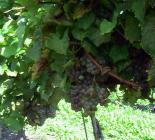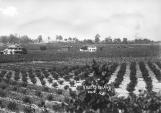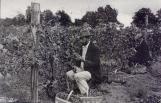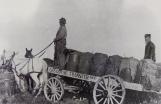1
Pelee Island Winery vineyard15 September 2011
Pelee Island, Ontario
 Credits:
Credits:Pelee Island Heritage Museum
2
Grape Growing PracticesTo establish a vineyard the costs were considerable, with estimates being $148.50 per acre in 1881. On Pelee Island, the density of vines per acre may have been more than triple the normal practice making it more expensive to plant per acre. In spite of the expense, grapes ranked third in significance for Ontario's fruit crops in 1860s and 1870s. Both growers and consumers had a choice of varieties to choose from on Pelee Island: Isabella, Delaware, Norton's Virginia Seedling, Schmidt's Seedling, Clinton, Hartford, Moore's Seedling, Ive's Seedling, Niagara, Rogers', Iona, Island Queen and the two most popular varieties - Concord and Catawba. Vines were acquired from many sources with preference given to local sources including Catawba and Bass Islands. It is believed that the earliest varieties planted on Pelee were from the Delaware and Catawba stock, these were chosen for the vineyard of Thaddeus Smith and the Williams Brothers. The Delaware grape originated in Delaware Ohio and the Catawba variety came from the banks of the Catawba River in North Carolina.
Choosing the varieties was dependent upon many factors, including climate. The average number of frost-free days on Pelee Island allowed the growers the opportunity to plant varieties that matured later on in the fall season. The most popular was the Catawba grape, and Pelee Island became the centre of Catawba production.
Site selection for the vineyard was also influences by different components, all playing a part in the success of the vineyard. Proximity to water, a sloping field for good drainage and movement of air, the presence of a limestone base beneath the soil, and application of aged cattle manure were all important factors.
The field was then ploughed and holes dug for the vines. Rows were spaced from seven to eight feet apart and vines planted every four or five feet within the rows. Given this spacing, one acre would support up to one thousand vines. After the vines were planted stakes were driven next to each vine. The stake was attached to the vine to ensure it would not grow crooked. Posts were placed next to every fourth or fifth vine. Eastern Red Cedar was particularly abundant on the island and thus made it a popular choice for the source of the vineyard posts. The posts were hung with three wires which made up the trellis system on which the grape canes were trained.
3
Acres of Vineyards (Kelley's Island)1910-1918
Kelley's Island, OH, United States of America
 Credits:
Credits:Charles E. Frohman Collection
R.B. Hayes Presidential Center
4
Once the pruning was finished a few other tasks needed to be completed including the application of fungicide. The application of sulphate of copper and hartshorn (made from the distillation of deer horns) was done to combat the effects of both powdery and downy mildew. Catawba grapes were more susceptible to mildew infections than the Concord. After the first application it was customary to tie the canes to the trellis using the shoots of the yellow willow tree. The winter was the time for the preparation of the willow shoots which were cut and split. These shoots were stored in cellars or other such damp places before being used. Each shoot was cut to twelve inch lengths and during the first tying the workers would have the willow bundles tied to their waists.In late June the families of the grape growers helped with the second tying. This time twisted rye grass was used grown on the island for this purpose. Cut with sickles and gathered in sheaves, it would take two or three straws to hold the new growth to the trellis.
6
The final job of the season was the harvest itself. Due to the differing ripening times of the grape varieties, harvest extended from late August to mid November. One of the early ripening varieties was the Niagara grape, the next group to mature were the Norton's Virginia Seedling, Ive's Seedling, Delaware, Isabella and the Concord. The last to be harvested was the Catawba. September and October were the busiest months and so a vineyard required a large labour force to help with the harvest. Whole families, including women and children and hired hands were enlisted to help with this task. Normally one worker picked one side of the row and at least two workers were needed per row. Stools were provided for the pickers and the tool of the trade was a knife or grape scissors to cut the grape clusters from the vine. If the laughing, singing, socializing or romancing did not preoccupy the workers too much, a picker could harvest up to one ton per day. About three workers were needed to harvest an acre in one day and scores of them were recruited from the mainland. Workers of the time could make as much as one dollar per day.Sources:
The Vinedressers, Ron Tiessen, Pelee Island Heritage Center, 1997
10
Henry Miller warehouseCirca 1895
Pelee Island, Ontario
 Credits:
Credits:Lake Erie Islands Historical Society



